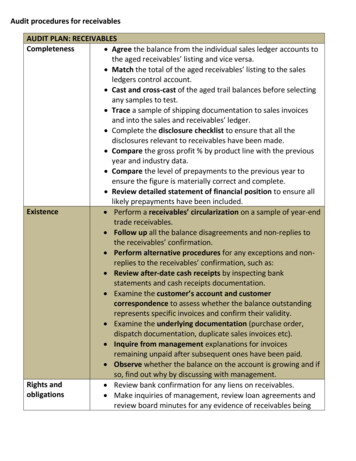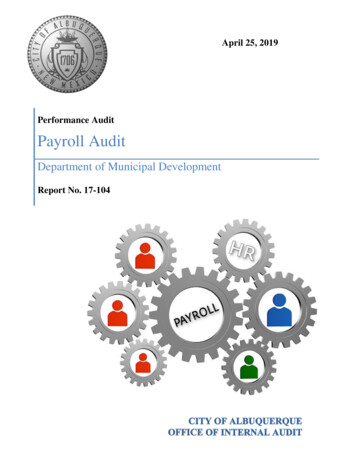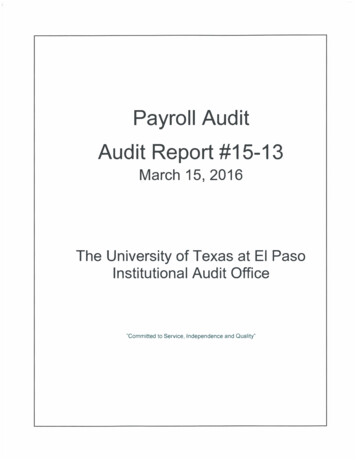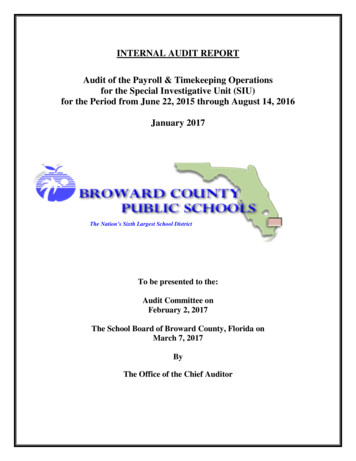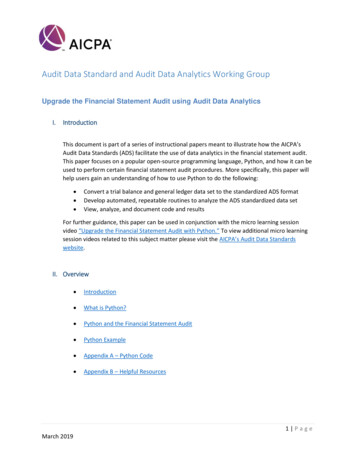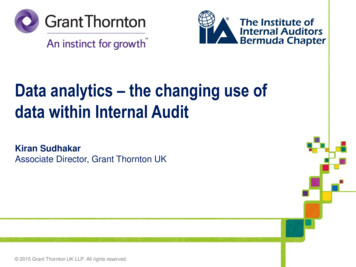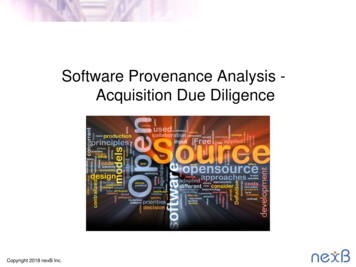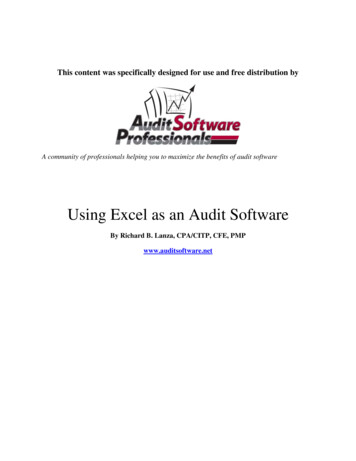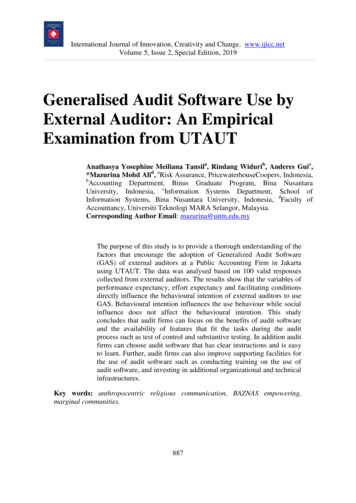
Transcription
International Journal of Innovation, Creativity and Change. www.ijicc.netVolume 5, Issue 2, Special Edition, 2019Generalised Audit Software Use byExternal Auditor: An EmpiricalExamination from UTAUTAnathasya Yosephine Meiliana Tansila, Rindang Widurib, Anderes Guic,*Mazurina Mohd Alid, aRisk Assurance, PricewaterhouseCoopers, Indonesia,bAccounting Department, Binus Graduate Program, Bina NusantaraUniversity, Indonesia, cInformation Systems Department, School ofInformation Systems, Bina Nusantara University, Indonesia, dFaculty ofAccountancy, Universiti Teknologi MARA Selangor, Malaysia.Corresponding Author Email: mazurina@uitm.edu.myThe purpose of this study is to provide a thorough understanding of thefactors that encourage the adoption of Generalized Audit Software(GAS) of external auditors at a Public Accounting Firm in Jakartausing UTAUT. The data was analysed based on 100 valid responsescollected from external auditors. The results show that the variables ofperformance expectancy, effort expectancy and facilitating conditionsdirectly influence the behavioural intention of external auditors to useGAS. Behavioural intention influences the use behaviour while socialinfluence does not affect the behavioural intention. This studyconcludes that audit firms can focus on the benefits of audit softwareand the availability of features that fit the tasks during the auditprocess such as test of control and substantive testing. In addition auditfirms can choose audit software that has clear instructions and is easyto learn. Further, audit firms can also improve supporting facilities forthe use of audit software such as conducting training on the use ofaudit software, and investing in additional organizational and technicalinfrastructures.Key words: anthropocentric religious communication, BAZNAS empowering,marginal communities.887
International Journal of Innovation, Creativity and Change. www.ijicc.netVolume 5, Issue 2, Special Edition, 2019IntroductionThe development of computer-based accounting in producing financial reports encouragesauditing practices to cope with technological advances. The auditors are required to switchfrom manual testing to the use of computer assisted audit techniques (CAATs). The use ofCAATs is encouraged in Indonesian Public Accountant Professional Standards (SPAP)Section 327 which states that using CAATs, auditors can overcome problems such as lack ofdocuments input or absence of an audit trail when conducting the test of controls andsubstantive tests. This research will focus on one type of CAAT namely Generalized AuditSoftware (GAS) because GAS is most often used by auditors to automate audit tasks (Ahmi& Kent, 2013). Despite the rapid technological growth in the current business and theencouragement of the regulator, previous research has shown that CAATs adoption byauditors is relatively low and auditors do not use CAATs regularly and systematically (Curtis& Payne, 2014). Mansour (2016) states that there are still few auditors who use GAS due tothe assumption that the software is difficult to use. Implementation of information technology(IT) is always associated with user acceptance. According to Nasir (2013) user acceptance isthe intention of a group of users in utilizing IT and it is an important factor affecting thesuccessful of IT implementation (Haseeb et al., 2019).Various models have been developed to assess individual behaviour as a technology user inacceptance of IT. In this research, the model used is UTAUT developed by Venkatesh,Morris, Gordon, and Davis (2003). The UTAUT was chosen because, firstly it combineselements of eight models that previously predicted acceptance of IT usage. Secondly,Venkatesh et al. (2003) illustrate that there are limitations to previous studies related to ITacceptance, such as the research being undertaken for relatively simple technology adoptiondecisions with research objects students being from the academic environment, and the issueof voluntary versus compulsory context. Therefore, the current study focuses on professionalexternal auditors’ adoption factors in GAS use.Several previous studies have analysed CAATs and GAS acceptance by auditors. Mahzanand Lymer (2014) examined the internal auditors’ acceptance of GAS in UK and found thatperformance expectancy and facilitating conditions influenced internal auditors' intentions toadopt GAS. Curtis and Payne (2014) surveyed senior auditors in implementing new auditsoftware. The results of the survey showed that performance expectancy, effort expectancy,and facilitating conditions are positively associated with a commitment to adopt auditsoftware. Gonzalez, Sharma, and Galletta (2012) also conducted research using UTAUT888
International Journal of Innovation, Creativity and Change. www.ijicc.netVolume 5, Issue 2, Special Edition, 2019model to investigate the auditor's intention to adopt continuous auditing tools and found thatthis model explains that effort expectancy and social influence significantly affect theintention to use CAATs while performance expectancy and facilitating condition do not.Bierstaker, Janvrin, and Lowe (2014) suggest that performance expectancy and facilitatingconditions increase the likelihood of auditors accepting and using CAATs and CAATstraining increases auditor's intention to use CAATs because it improves auditor performance.Ahmi and Kent (2013) suggest that most previous studies that examined the use of GASfocused on developed countries while research in the context of developing countries islimited, except in the case of Widuri, OConnell, and Yapa (2016) who studied the use ofGAS using a qualitative approach. Widuri et al. (2016) state that the use of GAS indeveloping countries is relatively new, therefore significant studies in this area are limited.The current research provides a thorough investigation of the factors that encourage or inhibitthe acceptance and use of CAATS especially GAS in an environment that is still relativelyless developed, especially in Indonesia.Literature Review and Hypotheses DevelopmentGeneral Audit Software (GAS)According to Ahmi and Kent (2013) GAS is a tool used by auditors to automate audit tasks.Since most accounting transactions are now computerized, accounting data is also expectedto be computerized as well. Previous research has shown evidence that many externalauditors have adopted GAS. For example, Mahzan and Lymer (2008) state that GAS iswidely used by internal auditors in the UK. The use of GAS may assist auditors to detectmisstatements in financial statements, particularly in assessing management assertions suchas completeness, ownership, assessment, accuracy, classification and disclosure of generateddata by accounting software (Debreceny, Lee, Neo, & Toh, 2005; Myeni & Mvuyana 2018).The Unified of Acceptance and Use of Technology (UTAUT)Unified of Acceptance and Use of Technology (UTAUT) is one of the accepted technologymodels developed by Venkatesh et al. (2003); Murshed, (2018). UTAUT (see Figure 1below) theorises that the acceptance of technology is influenced by five determinants, whichare (1) performance expectancy, which is “the degree to which an individual believes thatusing the system will help him or her to attain gains in job performance; (2) effortexpectancy, which is “the degree of ease associated with the use of the system; (3) socialinfluence, which is “the degree to which an individual perceives that it is important thatothers believe he or she should use the new system, (4) facilitating conditions, which is “the889
International Journal of Innovation, Creativity and Change. www.ijicc.netVolume 5, Issue 2, Special Edition, 2019degree to which an individual believes that an organizational and technical infrastructureexist to support the use of the systems, and (5) behavioural intention, which is “the person’ssubjective probability that he or she will perform the behaviour in question”. The UTAUTmodels predict that gender, age, experience and voluntary use moderate the fourdeterminants.Figure 1. UTAUT Model, adopted from Venkatesh et al. (2003)In addition Venkatesh et al. (2003) have ensured the robustness of the models they create.The results show that their models are valid, outperformed previous models, were verysupportive and explained up to 70 percent of the variants regarding the intended use oftechnology, and 50 percent of the variants regarding the use of technology (Venkatesh,Thong, & Xu, 2012).The influence of Performance expectancy on Behavioural intentionPerformance expectancy refers to a person believing that the use of technology can help theachievement of job performance (Venkatesh et al., 2003). In the audit context, the authorspredict that when an auditor gains advantage by using audit software, the auditor willincreasingly intend to use audit software in the audit process, but when the auditor does notget benefit from the use of audit software, the level of willingness to use audit software willdecrease. The apparent benefit when using a GAS is that it can assist the auditor in audit time890
International Journal of Innovation, Creativity and Change. www.ijicc.netVolume 5, Issue 2, Special Edition, 2019completion and budget, reducing the time spent in performing tests of controls andsubstantive tests and potentially increasing the level of audit effectiveness.Research conducted by Bierstaker et al. (2014) shows that performance expectancy affectsthe intention of CAATS use in auditing by auditors in the United States. In addition, Mansour(2016) shows that performance expectancy affects the intention of CAATS use in auditing.Due to the alleged linkage between perceived benefits when using the system withbehavioural intent to use, the following hypothesis is presented:H1: Performance expectancy affects the Behavioural intention of external auditors inJakarta to adopt and use GASThe influence of Effort expectancy on Behavioural intentionEffort expectancy refers to the degree of ease of use of the tool (Venkatesh et al., 2003).Effort expectancy describes perceived ease of use and perceived level of complexity. In theaudit context, the authors predict that when the auditor feels the ease of using and thecomplexity of audit software is low then the auditor will intend to use audit software in theaudit process however when auditors find it difficult to use audit software because thesoftware is too complicated or difficult to understand then the auditor will not want to use it(Siala Bouaziz and Jarboui, 2019).Research conducted by Curtis and Payne (2014) states that effort expectancy will affectbehaviour intention. They state that Performance Expectancy mediates the relationshipbetween effort expectancy and behavioural intention due to budget pressure in audit settings.However, different results are proposed by Bierstaker et al. (2014) indicating effortexpectancy has no significant effect on CAATS intentions due to responsibility, whereby theauditor should collect competent audit evidence thus prioritizing effectiveness in makingaudit decisions (Falkowski, 2010). Due to differences in research results and the existence ofalleged linkages between the level of ease of using the system with the intention of behaviourto use, the following hypothesis is presented:H2: Effort expectancy affects the external Behavioural intention of external auditor inJakarta to adopt and use GASThe influence of Social Influence on Behavioural intention891
International Journal of Innovation, Creativity and Change. www.ijicc.netVolume 5, Issue 2, Special Edition, 2019Social influence can be defined as the extent to which a person feels that another personbelieves that he or she should use this new tool (Venkatesh et al., 2003). In the audit, theauthors predict that the more significant support is provided by the manager andencouragement from external parties to use GAS, the more it encourages the auditor to acceptand use GAS conversely when the auditor does not get support to use GAS either from theexternal parties such as clients and regulators or internal stakeholders such as managers orcolleagues the auditor's intention level to use GAS in the audit process will decrease.Research conducted by Curtis and Payne (2014) state that social influence affects theauditor's intention to use CAATS. These results contradict the results of Bierstaker et al.(2014) which suggest that social influence does not affect the intention to use CAATS. Thisimplies that external auditors from the United States feel that social influence is not animportant factor that encourages their intention to use and adopt CAATS. Due to differencesin the research findings and the alleged linkage between the level of social support to use thesystem with the intention of behaviour to use, the following hypothesis is inferred:H3: Social influence affects the Behavioural intention of external auditors in Jakarta toadopt and use GASThe influence of Facilitating Condition on Behavioural IntentionFacilitating conditions are defined as the degree to which one believes that organizational andtechnical infrastructure exists to support the use of the system (Venkatesh et al., 2003). In theaudit context, the authors predict that when support facilities such as the availability ofknowledge, software and hardware are available regarding the use of GAS thiswill improvethe auditor's intention to use GAS. Conversely, when the facilities needed by auditors are notavailable, it will decrease the level of willingness of auditors to use GAS.According to research conducted by Bierstaker et al. (2014) the relationship betweenfacilitating condition and the intention of using CAATS, has a positive correlate. This impliesthat if the audit firm provides the necessary resources, infrastructure, knowledge andassistance then the intentions of external auditors to use CAATS are expected to be high.Different results are presented by Gonzalez et al. (2012) who did not find facilitatingconditions encouraging the use of CAATS in internal audit. Due to the difference in researchresults and the existence of connection between facility availability with behaviour intentionto use, the following hypothesis is presented:892
International Journal of Innovation, Creativity and Change. www.ijicc.netVolume 5, Issue 2, Special Edition, 2019H4: Facilitating condition affects the Behavioural intention of external auditors inJakarta to adopt and use GASThe Influence of Behavioural intention on Use behaviourBehavioural intention is defined as “the person’s subjective probability that he or she willperform the behaviour in question” (Venkatesh et al., 2003; Hussain et al., 2018). A personwill be interested in using a new information technology if the user believes using theinformation technology will improve performance, using information technology can be doneeasily, and the user gets support from the surrounding environment and the availability offacilities in using the information technology. Use behaviour is described as the intensity ofthe use of a technology in everyday life. The relationship between the behavioural intentionand the use behaviour is said to be positive. If the intention or interest for the utilization ofexisting IT by an individual is high, the probability of that person using the IT (usebehaviour) is also high. Venkatesh, Morris, and Ackerman (2000) and Venkatesh et al.(2003) suggest that higher behaviour intention leads to higher frequency of use (Namazi andNamazi, 2017). Due to the alleged linkage between behavioural intent to use withbehavioural usage, the following hypothesis is presented:H5: Behaviour intention has an influence on the Use behaviour of external auditors whowork in public accounting firms in Jakarta to adopt and use GASResearch MethodThe respondents for this study were external auditors who work in a Public Accounting Firmin Jakarta. This study distributed a paper-based questionnaire to 100 auditors to examine theirperception on the use of GAS. The questionnaire in this research is developed fromVenkatesh et al. (2003) and consisted of 21 questions based on six variables as described inthe proposed research model (see Figure 2). The questions were measured using a five-pointLikert scale, ranging from “1” (strongly disagree) to “5” (strongly agree). The proposedresearch model describes variables used in this study, which are performance expectancy,effort expectancy, social influence and facilitating conditions as independent variables.Behavioural intention as an intervening variable and use behaviour is a dependent variable.This research performed the Structural Equation Modelling (SEM) using Smart PLS V3 seeFigure 2 below.Figure 2. The Proposed Research Model893
International Journal of Innovation, Creativity and Change. www.ijicc.netVolume 5, Issue 2, Special Edition, 2019Research ResultsDemographic Statistics of the RespondentsBased on the data collected in this study where 100 questionnaires were returned, Table 1below describes the respondent demographics.Table 1: Respondent DemographicsCharacteristicsContentsMaleFrequencies percent4747%Cumulative Percent47%Female5353%100% 256464%64%26 - 352929%93%36 - 4555%98% 0%Doctoral00%0%GenderAgeEducation Level894
International Journal of Innovation, Creativity and Change. www.ijicc.netVolume 5, Issue 2, Special Edition, 2019 37878%78%3 -51515%93% upervisor44%99%Partner11%100%Voluntary UseYes6464%64%Audit SoftwareNo3636%100%Big 45353%53%Non Big 447Years As AnExternal AuditorPositionAudit Firm Size47%100%Based on 100 respondents, there were 64% of respondents aged 25 years, 29% ofrespondents aged 26-35 years, 5% of respondents aged 36-45 years, and 2% of respondentsaged 46 years. This indicates that the majority of respondents are 25 years old. Themajority of respondents are women as many as 53 people (53%) and most of the respondents(84%) hold bachelor degree. Most respondents have worked less than 3 years in the currentPublic Accounting Firm (78%) and accordingly the majority of respondents have a positionas a junior auditor that is 75 people (75%). There were 64 people (64%) claiming to use audit895
International Journal of Innovation, Creativity and Change. www.ijicc.netVolume 5, Issue 2, Special Edition, 2019software voluntarily. The majority of respondents work in Big 4 Public Accounting Firms(53%).Hypotheses AnalysesA test outer model was conducted to test the reliability and validity of the question items andanswers to the questionnaire through the reliability test and validity test and an inner model totest the accuracy of the variable.Test outer model in PLS was completed by testing the convergent validity and discriminantvalidity and reliability. Convergent Validity measures the validity of the reflexive indicator asa variable gauge of the outer loading of each variable and AVE indicator and this can be seenin Tables 2 and table 3 below:Table 2: Outer LoadingVARIABEL LOADING FACTORKRITERIAKETERANGANPE0,799 - 0,931 0,700ValidEE0,772 - 0,912 0,700ValidSI0,804 - 0,871 0,700ValidFC0,837 - 0,919 0,700ValidBI0,841 - 0,913 0,700ValidUB0,930 - 0,932 0,700ValidSource: processed using Smart PLS V.3Table 3: AVEVARIABEL AVEKRITERIAKETERANGANPE0.732 0.5ValidEE0.696 0.5ValidSI0.713 0.5Valid896
International Journal of Innovation, Creativity and Change. www.ijicc.netVolume 5, Issue 2, Special Edition, 2019FC0.785 0.5ValidBI0.787 0.5ValidUB0.867 0.5ValidSource: processed using Smart PLS V.3Discriminant validity is achieved by testing Cross loadings and Fornell-Lacker Criterionwhich is presented in Tables 4 and 5 below:Table 4: Cross ,4710,4630,4620,4380,3500,289EE40
factors that encourage the adoption of Generalized Audit Software (GAS) of external auditors at Public Accounting Firm in Jakarta a using UTAUT. The data analysed based on 100 valid responses was collected from


